Things to know before starting the harmony part of this lesson 1)The Diatonic Movements of the Major Scale 2)The Intervals of a Major Triad Ok, let's look at the Major Diatonic scale. It consist of seven chords but all using the same notes of the signature key. In this lesson we are in the key of C. Often the seven chords will be labeled as Roman Numerals(I II III..). The Roman Numerals will also be upper case(I II) depicting Major Chords or lower case(i ii) for minor chords. The Diatonic Major Movements we will be using will follow this order.. I..ii..iii..IV..V..vi..viidim. (NOTE: the seventh or vii is Diminished represented by viidim). Learning The PatternLooking at the order we see this pattern... MAJ...min...min...MAJ...MAJ...min...dim(also a min). The last MAJOR is the same as the first MAJOR just one octave higher. 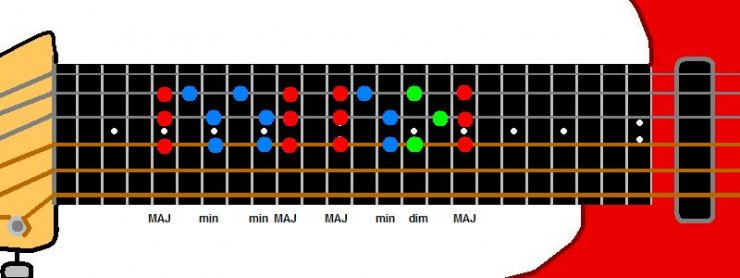 Looking at the above chart you see the Diatonic Chords. I am only using 3 notes per chord for each movement to make it easy on you...and ME!! Strumming each chord sounds like this... All of the chords above have the same intervals. The 5th is the lowest note or D string. The 1st is the middle note or G string. The 3rd is the high note ore B string. The 1st is always the root or focal point for the harmonies throughout this lesson. Harmonizing 1st and 3rd IntervalsLet's look at the positioning of these intervals and the changes from Major to minor.. 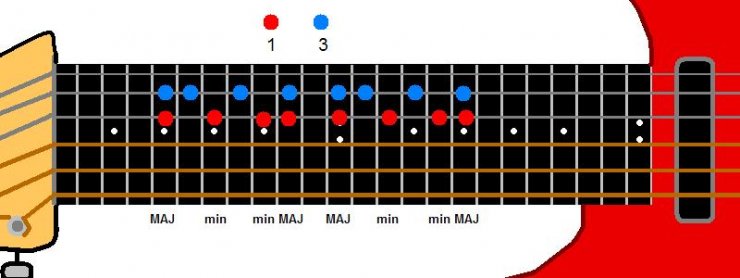 The chart shows the 1st or root notes with red markers and the 3rds as blue markers. Positioning on the G & B will follow this pattern...the 3rd is ALWAYS directly above the 1st on Major harmonies and flatted for minor harmonies. NOTE: This pattern is only for G&B string harmonies due to the B strings flatted tuning.(yeah, there's one in every crowd). Look at the 1st. If you played just the 1st on the G string you would be playing a Major scale with the intervals being 1-2-34-5-6-78. Notice there are no spaces or frets between 3&4 and 7&8. Keep this in mind as you begin to move the phrasing around from one set of notes to another. Listen to the example as it walks up each set of notes creating the harmony. Remember to use the 1st as your point of reference. Use the Diatonic Movements.. MAJ...min...min...MAJ...MAJ...min...dim(also a min). This pattern will repeat itself after every 12 frets. 1st and 3rd Harmony Throughout The FretboardThis harmony can be played various places but first we need to shift positions on the intervals. 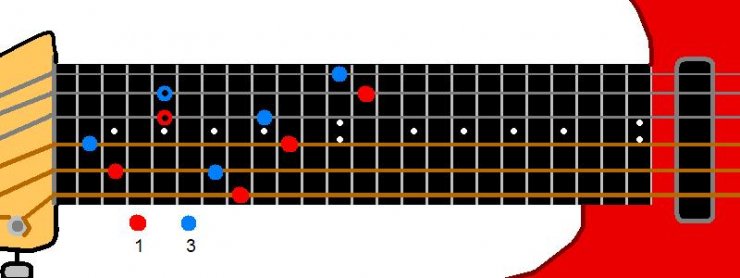 This is the 1&3 intervals for the other string positions. Now the rule changes. The Major 3rd is still on the higher string but has been flatted from the position the G&B harmony strings use(see the dotted notes on the 5th fret). This is the most common 1st 3rd interval and should be noted that this is what defines every Major chord as being a Major. Use these as your point of reference for the Major harmonies. 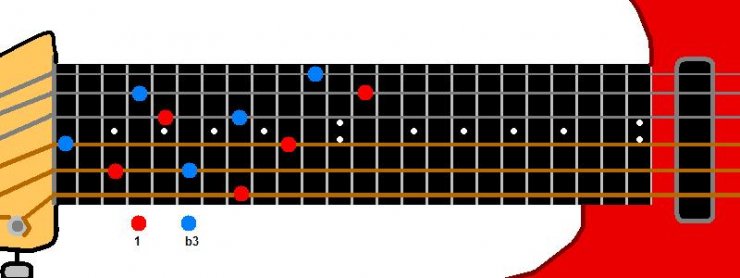 This image is the same as above but with the 3rds flatted (deja vu flat). Use this interval for the minors in the Diatonics. 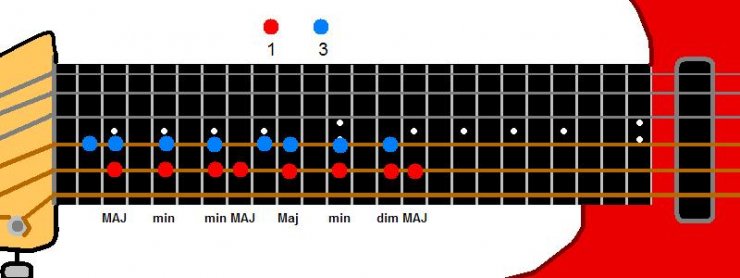 These are the intervals to be used on all the Major movements.(Use first chart of this section to find the various starting points on all strings). Alternate 1st And 3rd IntervalsIf it were not for players like Eric Johnson or Buckethead. and countless others, playing might get boring but these guys are always finding something to bend, twist and completely change the way things are normally done. And we love it. So alternate voicing comes in to play. Alternate voicing is just another way of playing chords. Example: To make an open C you use 1 3 5 1 3 but to make an A shape C chord(see CAGED lesson by Empirism)you would use 1 5 1 3 5. Same chord different voice or structure of notes. 1st and 3rd can be played like this..  I made this one before the color coding came to mind so i got some 'splainin to do. The lower E string contains your roots and the G string is the keeper of the 3rds. The E string still follows the Major scale pattern while the G string takes care of the Major and minor 3rds. We still keep the Major Diatonic Movements..MAJ...min...min...MAJ...MAJ...min...dim. And it sounds like this... Ok you can stop playing Blackbird now and get back to the lesson. :) This is an excerpt from Whitewash by Buckethead..without the effects. Harmonizing 1st And 5th Intervals1st and 5th intervals are the easier of the harmonies in this lesson due to the fact that 5ths are not affected by Major or minor chords. The 5th is flatted on the Diminished harmony only. 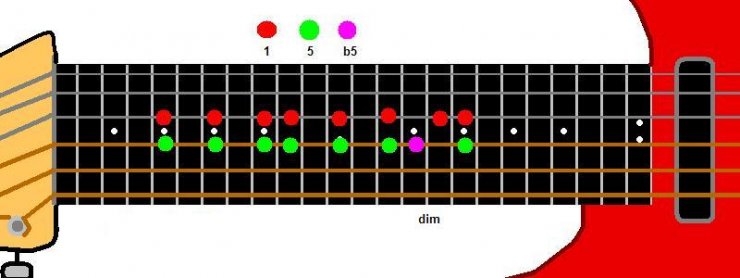 There are two intervals of the 1st 5th combination. The first is shown above. There will always be a 5th directly below the 1st unless noted,b5..#5..Diminished and Augmented. This does not apply when the B string is used for the 1st or root notes.  This is the second interval of the 1st 5th harmony. We all know how to make power chords(power intervals to some) so this should come to you quite easily. I placed dots on the corresponding notes to insure the right notes are matched up. If you play the 1st below the 5th you have a 4(IV) chord but that's another lesson. 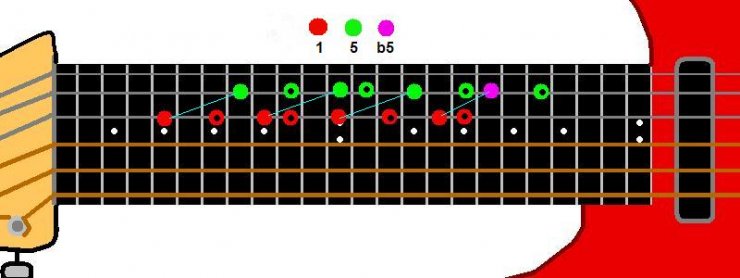 On the next inversion you are using the power chord but the 5th is raised due to the B string.. AGAIN.  The last inversion is another where the B string changes the placement. Remember on ALL of the 1st 5th variations the 5th changes position only on the Diminished movement. HARMONIZING 3RD AND 5TH INTERVALSThe 3rd 5th harmony in my opinion is the coolest sounding of all due to the fact there is no rootmaking it sound like you're playing a different key. Actually you are! The 3rd 5th in the key of C is the 1st 6th in the key of G. 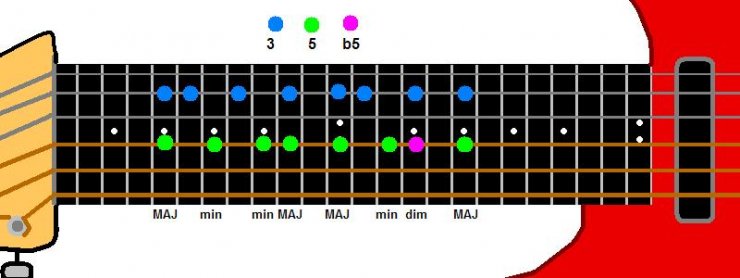 Notice the Diminished. It looks like a Major pattern but if you refer to the first chart at the top of the lesson you will see that the 1st is on the 16th fret. The 3rd and 5th are flatted... Harmony Using ChordsThis is a trick to harmonize by holding a chord-plucking two strings-then mute the strings quickly. Works easiest with barre chords. Now try the same method while you change chords..this example uses Cm Bb Ab Gm7 And that is the end of this one. Not a hard lesson but I think it can get a beginner off to a good start.
Comments:
01
07.29.2010
02
07.29.2010  MoshZilla1016 MoshZilla1016
Thanks Jazzy but I'm really glad that I can edit the lesson. After I submitted I realized that I forgot the 3rd 5th harmony.
03
07.29.2010
04
07.29.2010
05
07.29.2010  Empirism Empirism
Now, this is cool lesson. Easy to follow and clear. How you, or have you any methods to memorize these patterns (if there are any tricks) or do it comes naturally by time when playing with these.
06
07.31.2010  MoshZilla1016 MoshZilla1016
@lettonico- Thanks man glad u liked it. Hope it helps you
07
08.01.2010
08
08.01.2010
09
08.01.2010  MoshZilla1016 MoshZilla1016
Nullnaught-- 2 part harmony is when two different notes from the same scale are played together to make a harmony. Boston, Maiden and Avenged Sevenfold (plus many others) use this in their solos and some rhythm patterns. This lesson is just showing how it can be done with one guitar.
10
08.04.2010
11
08.04.2010  MoshZilla1016 MoshZilla1016
Thanks man. I'm waiting for your next lesson. I've gone over your past lessons..KILLER.
12
01.26.2011
13
01.26.2011 |


